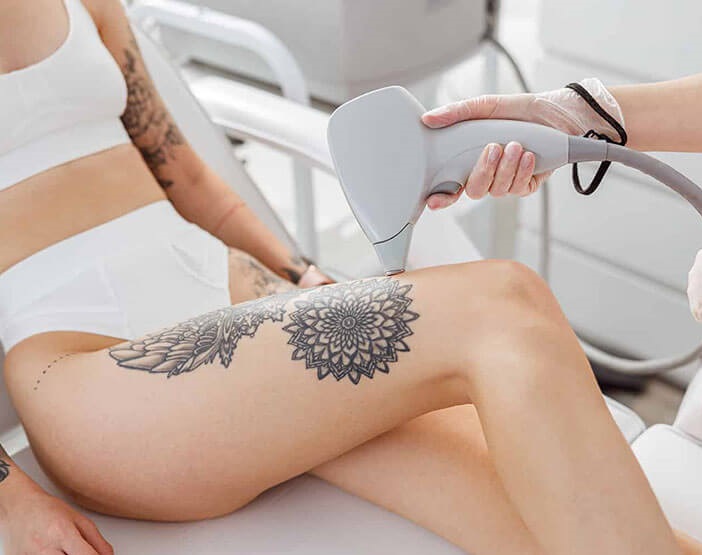Tattoos can be deeply personal expressions, but tastes, lifestyles, or circumstances often change over time, leading individuals to seek ways to eliminate or conceal unwanted ink. Two main options dominate the conversation: laser tattoo removal and tattoo cover-up. Both methods have their own appeal, benefits, and drawbacks. Deciding which is better depends on the person’s goals, tattoo characteristics, and expectations. This article explores these two approaches, highlighting the key differences and helping you make an informed decision.
How Laser Tattoo Removal Works:
Laser Tattoo Removal in Dubai (إزالة الوشم بالليزر في دبي) relies on advanced technology that breaks down the ink particles in the skin. This is typically done using Q-switched lasers or newer picosecond lasers, which emit high-intensity light beams that target specific ink pigments. As the laser penetrates the skin, it shatters the ink into smaller particles, which the body’s immune system gradually removes. The process requires multiple sessions, spaced weeks apart, and results in the progressive fading of the tattoo. Laser removal is considered the most precise and modern method available today.
Understanding Tattoo Cover-Up Techniques:
Tattoo cover-ups involve using new ink to mask the original design with a fresh tattoo. Skilled tattoo artists use darker colors and clever design strategies to hide the old artwork. The process often includes creative redesigning, color correction, and strategic layering. Cover-ups can be completed in one or a few sessions, depending on the size and complexity. However, not all tattoos are ideal candidates for cover-ups—dense black ink, large designs, or scarred areas can pose significant challenges.
Comparing the Results: Clarity vs. Creativity
One of the most noticeable differences between laser removal and cover-up is the final result. Laser tattoo removal aims for complete erasure or maximum fading, ideally leaving skin as close to its original state as possible. For many, this means a clean slate and the ability to move forward without any visual reminder of the old tattoo. On the other hand, cover-up tattoos transform the existing ink into something new. While this allows for creativity and aesthetic value, the final piece is often larger, darker, and more intricate to ensure effective concealment.
Skin Impact and Healing Process:
Laser removal and tattoo cover-ups affect the skin differently. Laser removal involves minor skin trauma, often compared to a sunburn or blistering, and requires diligent aftercare to prevent scarring or pigmentation changes. The healing process is gradual, occurring between sessions and continuing after the final treatment. Cover-ups also involve skin trauma, as fresh ink is applied over healed or previously tattooed areas. The healing process is similar to a new tattoo, but if the old tattoo was heavily scarred, the results may not heal evenly or might show irregular textures under the new design.
Flexibility and Future Options:
Laser tattoo removal offers more long-term flexibility. Once the tattoo is removed or significantly faded, the individual can choose to leave the area blank, get a new tattoo, or even start a partial cover-up with a much lighter base. This method provides greater freedom for future decisions. In contrast, a cover-up tattoo is essentially a commitment to another permanent design. While this may be satisfying artistically, it limits the ability to make changes later and may require even more complex removal if desired down the road.
Pain and Tolerance Levels:
Pain tolerance varies from person to person, but both procedures can cause discomfort. Laser removal is often described as more painful than getting a tattoo, especially during the initial sessions. The sensation is commonly likened to snapping rubber bands against the skin or a warm prickling. Cover-up tattoos, on the other hand, feel similar to the original tattoo process. However, since they often require deeper saturation and may go over sensitive or scarred skin, the experience can still be intense. Choosing between them may come down to whether one prefers short bursts of pain across many sessions or prolonged sessions of tattooing.
Final Verdict:
The choice between Laser Tattoo Removal in Dubai (إزالة الوشم بالليزر) and a cover-up depends on personal preferences, tattoo characteristics, and long-term goals. If you’re seeking a clean slate, have a tattoo with sentimental baggage, or want to eliminate the ink completely, laser tattoo removal may be the better option. However, if you’re artistically inclined, open to new designs, and working with a skilled tattoo artist, a cover-up can offer a fresh and meaningful alternative. Both approaches have evolved significantly in recent years, and with the right planning, either path can lead to a satisfying outcome.







0 Comments